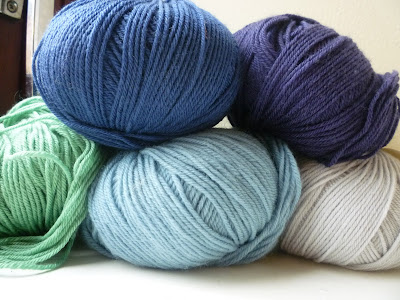Planning a knitting project is really exciting – deciding on your pattern, selecting your wool and starting to knit, full of excitement about the item you are going to create. Today I am going to share a few tips on how to make sure your projects go smoothly from start to finish...
- Don't be put off by something looking too difficult – challenge yourself and give it a go. You can learn new techniques along the way. There is an abundance of advice available online too.
- Consider when and where you like to knit. Are you looking for something to occupy your hands and help you unwind? Maybe rows of stockinette are just what you need. Do you want something absorbing? Try colour work or something with stitch or cable patterns that demand that you pay attention. Do you like to knit on the train or bus? A small portable project (socks, sections of a items which get sewn together) is what you need - a top down raglan sweater knitted in the round is going to be a huge pain to carry about!
Yarn
- Make sure you have enough for the project and that is from the same dyelot, as dyelot colours can vary noticeably. If using a different yarn from the type given in the pattern make sure it is of the right weight but also that the yardage/metrage matches with the pattern, not just the number of balls/skeins advised.
- Make sure it is the right type of yarn for the project - cotton behaves very differently from wool. Read Kristen's comprehensive post about fibre types to learn more.
- Make a gauge swatch. It seems like a pain but is so worthwhile to make sure you are knitting within the recommend parameters of the pattern. It also allows you to see how the wool looks when it is knitted up.
- Make sure you have the right size needles for you to achieve the recommended gauge. Some patterns may recommend up to 3 or 4 needle sizes, as rib is usually knit on smaller needles than the main body of a garment, or a circular knitting project might recommend double pointed needles as well as circular if the number of stitches gets small.
- When you're starting out it can add a lot to the cost of a project to buy needles - read the pattern carefully and make sure that you have the needle size used most often in the garment. You will want to check your gauge with this before buying a whole host of needles that end up being wrong for the project.
Knitting your Pattern
Read the pattern through before beginning.
- This will give you an idea of what you'll be tackling and what you might need. Maybe you don't even need the smaller gauge of needles till the end of the project so you start knitting without having to buy everything in one go at the beginning, spreading the cost.
- A read through will also give you an idea of how it will be to knit – is there a cable pattern repeat that is easily memorised? Great! You can knit away quickly. Will you need to have the pattern in front of you at all times to negotiate difficult stitch or colour work? Fine – but it's good to think about that before you commit to the project! Do you hate sewing pieces together? Try something you can knit in the round – it can always be converted to be knit the way even if the pattern is written for knitting flat.
Handmade mittens (£2 charity shop purchase)
Tricky Patches
- Sometimes you will get fed up of your knitting. This might be because the pattern is boring or difficult or you don't feel like you're getting very far. No problem - try something new. Knitting is supposed to be fun and a hobby after all!
- It can be really useful to have more than one project on the go at one time. Different projects have different virtues – socks are great portable items, a jumper with rows of stockinette can be knit in front of the TV without having to pay too much attention to your hands, multi-ball fairisle needs a bit of space to lay out wool and pattern, aran and bulky items knit up quickly for a satisfying result. There is a knitting project to suit every mood.
- It's ok to still buy knitted items! Although this gets harder when you can knit to a decent level, you probably won't have time to knit everything you want. I find that being able to knit has given me a real appreciation for hand knitted items I find in charity shops, although I can't bring myself to spend £42 in Topshop on a cardigan that is 90% acrylic and 10% wool.
What tips and tricks have you picked up along the way, to ensure your projects turn out the way you want?
K x


















I haven't purchased high street sweater-knitwear since I've started knitting full-on garments! I'm with you on the hand-knitted charity shop items too, I have such an appreciation for hand-knits. Thanks for linking up my yarn post, I'm glad you found it share-able!
ReplyDelete